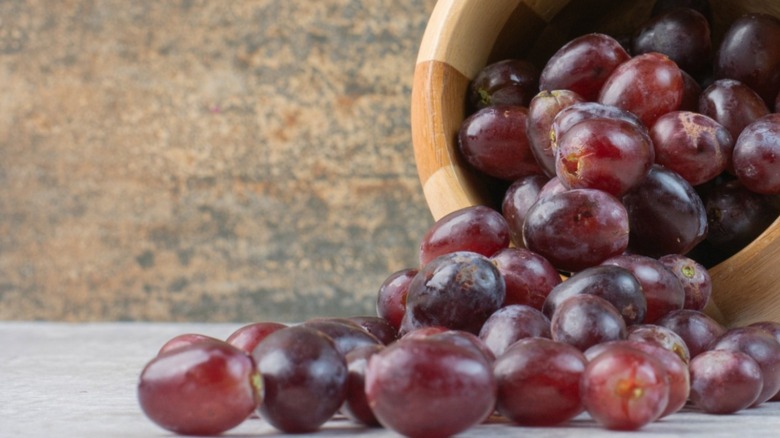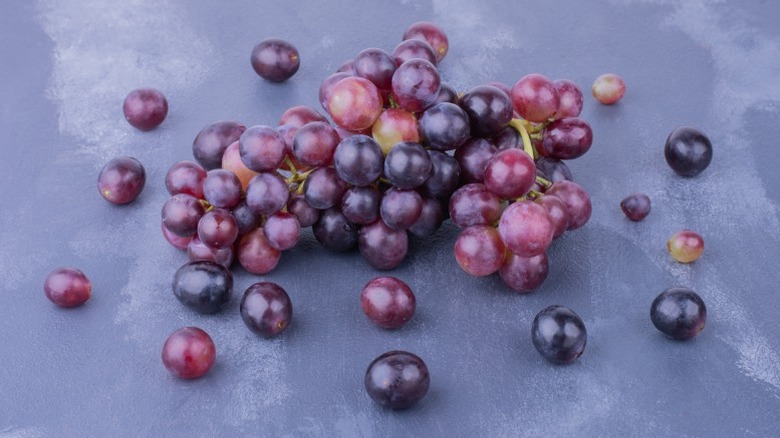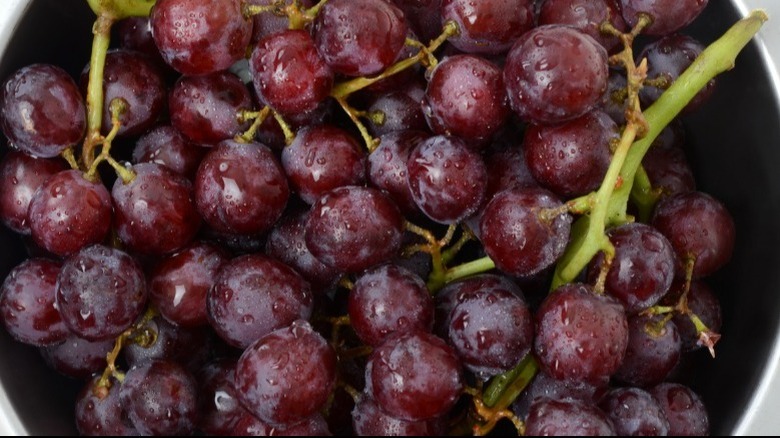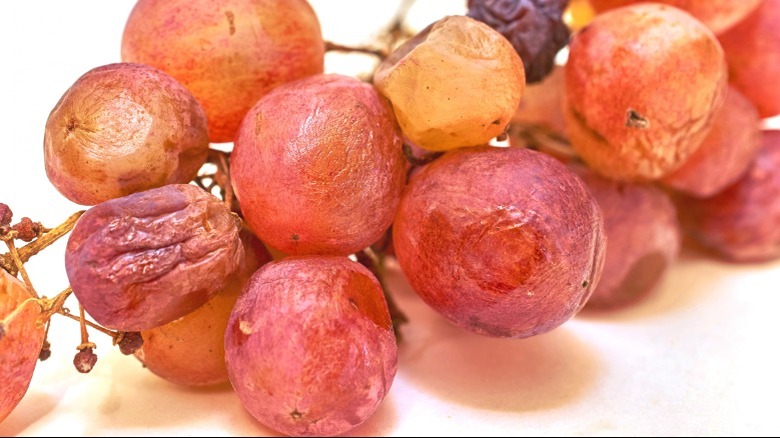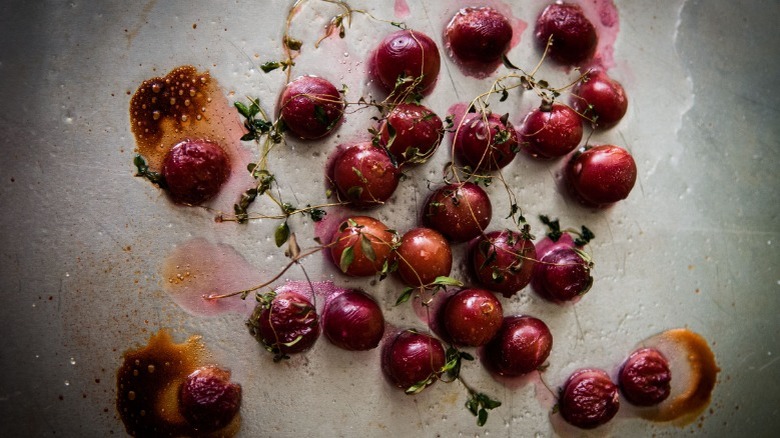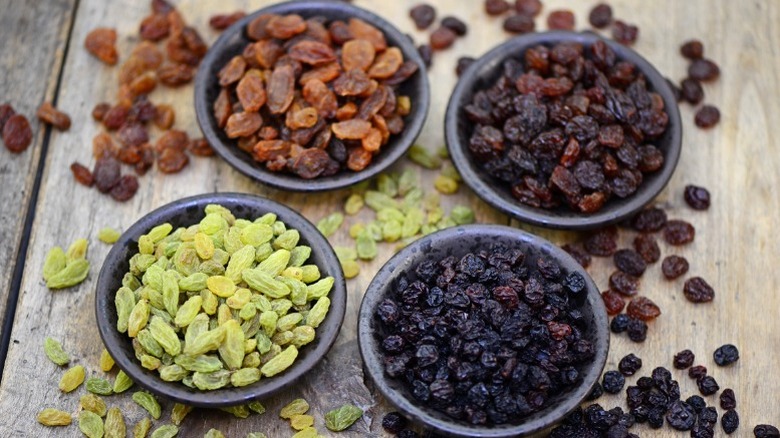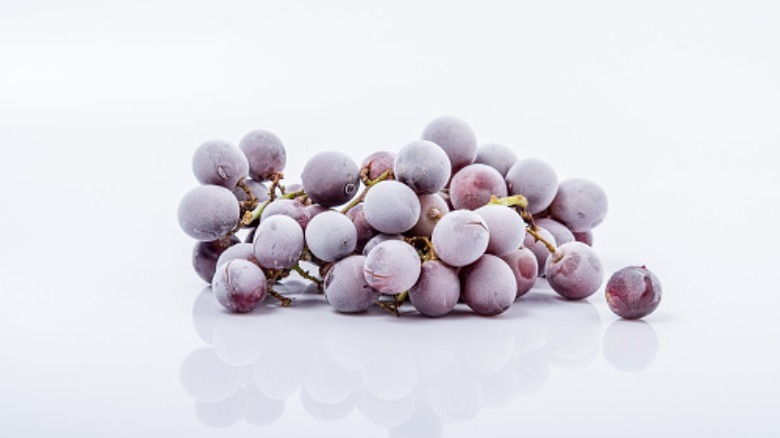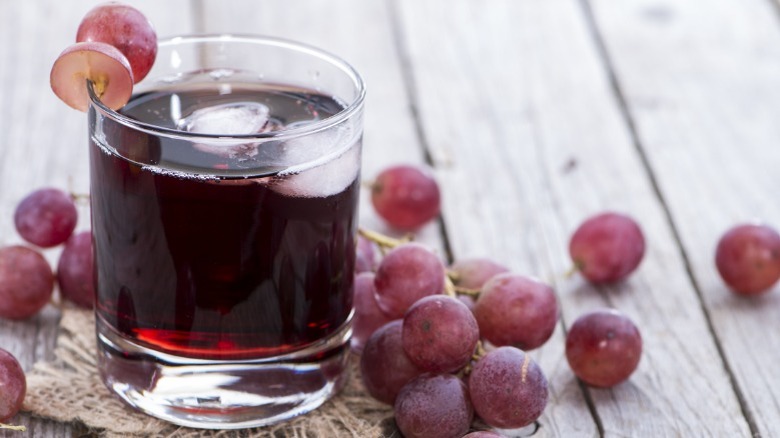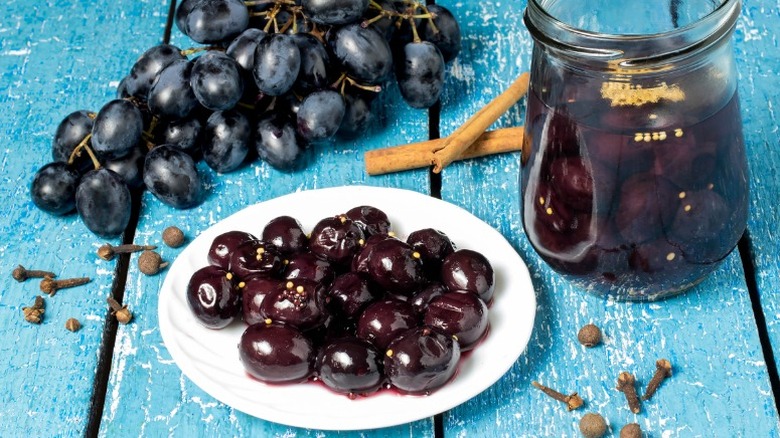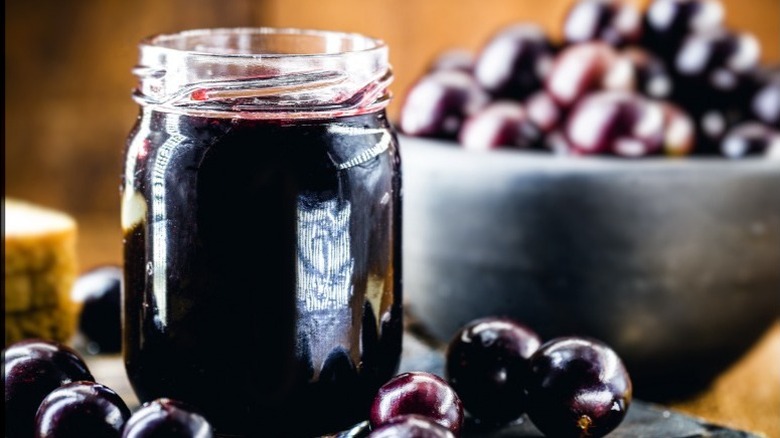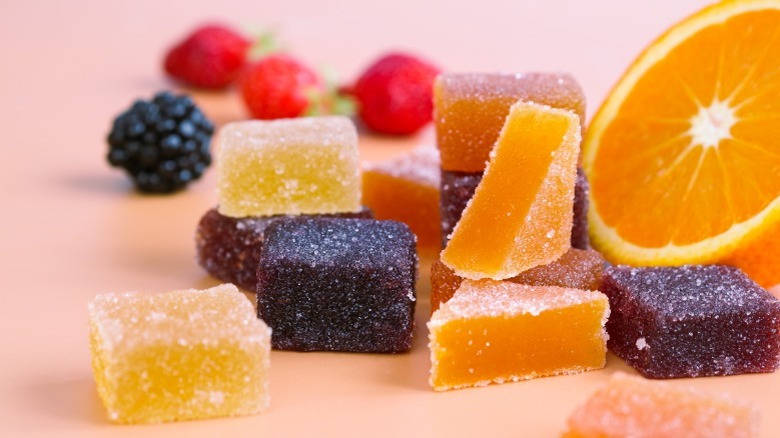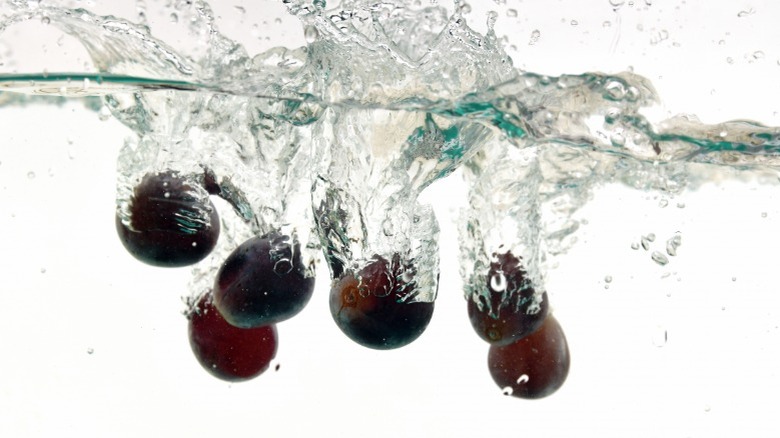12 Tips For Repurposing Overripe Grapes
Some fruit is well-known for having a very short life once you bring them home — raspberries, avocados, and peaches come to mind. Grapes, on the other hand, are fairly sturdy and, if you're storing them properly, they'll last for a while before it's time to panic about what to do with them.
Before we get to all the things you can do with your piles of overripe, yet still viable, grapes, let's go over the difference between table and wine grapes. It might not sound like a big deal, but it will make a difference in how you proceed. The majority of grapes sold in grocery stores are table grapes and are specifically for eating. Generally seedless and with thinner skins, you can use these grapes (red or green) in any of the applications listed below. As for wine grapes, you might find these easily if your farmers market is located in a region known for vineyards or you might be growing them yourself. Wine grapes tend to have seeds and a thicker skin so you'll have to make adjustments on occasion, like increasing cook time. You can slice them in half and remove the seeds if you don't care for the crunch.
Once you've gotten a handle on what you're working with, read on to find a way to salvage those gorgeous grapes by repurposing them into a frozen treat, a handful of raisins, or a terrific addition to your charcuterie board.
Mistakes you're making when buying grapes
Before those grapes even make it into your fridge, let us give you a little advice for picking the best bunches at the grocery store or farmers market. It might sound obvious, but you should avoid buying grapes that are already at their ripest unless you have immediate plans for them. If your bunch is perfect today but you won't get to them for a couple of days, you've already set yourself up for fruity failure. According to Foodal, you should inspect your bunch to make sure that there aren't any discolored grapes, because that will just lead to rot faster than normal. When you pick up the bunch, you shouldn't notice many grapes falling off; everything should be plump and still well attached to the stems.
A telltale sign that your grapes are still juicy and fresh is the presence of bloom. Bloom is the white, powdery, sometimes slightly waxy, coating that you will often see on the flesh of fruit. Avoiding this is actually one of the mistakes everyone makes when buying grapes because bloom is, in fact, a good sign. It's naturally produced by grapes to protect them from rot and helps to contain moisture. A nice coating of bloom usually means that those grapes are ripe and juicy.
The best way to store grapes
Once you get your produce home, what can you do with it to make it last? Grapes in particular benefit from being stored in the fridge so resist the urge to leave them on the counter. Before putting the bunch away though, pull it out of the bag and give those globes a once over to remove any grapes that might not be in the best shape. Because of the close proximity of grapes in a bunch, one damaged grape will lead to many more in a short time.
After giving it a quick appraisal, return the bunch to the bag it came in (they're made specifically to preserve freshness) and put it into your fridge. Preferably closer to the back or in the crisper, says Healthy Family Project, because that's where it's the coldest. They go on to say that you shouldn't rinse your grapes until you're ready to eat them as this will rinse off that protective bloom and all that additional water will lead to rot, too. Finally, try to avoid storing your grapes near anything with a lot of aroma — grapes have a thin skin and can easily pick up flavor or scent from items like garlic, onions, or pungent cheese.
How to know when your grapes have gone bad
Generally, it's pretty easy to tell when your grapes have started to go bad. The most obvious signs include mold or rot and really withered, puckered skin (mild wrinkles just indicate that time is running out). However, there is another simple way to tell if your grapes have gone bad — the good old sniff test. While sour and fermented grapes are considered tools of the trade in making wine and vinegar, only fresh and sweet will do for eating out of hand. A bunch of grapes with a sour or vinegary odor is past its prime and shouldn't be ingested. Unfortunately, at that point, there isn't much you can do except toss it in the compost.
If the bunch still smells good but you notice a few individual grapes have started to discolor or wither, just pull those ones off and discard them. You should find that the rest of the bunch is still great and, by removing the less-than-perfect ones, you will have extended the life of the rest. If you suspect that your grapes are just a little overripe but still eminently edible, read on for some suggestions of what to do with those under-plump but still delish beauties.
Roast them for a surprising addition to dinner
One of the techniques that you might want to add to your repertoire is roasting grapes as an unexpected side dish. When roasted, grapes go superbly with proteins like pork or chicken. Leave them on the vine for easier handling, but rinse before putting them in a 120 degrees Fahrenheit oven on a lined baking sheet. Hill Street Grocer suggests hitting them with some salt if you're planning to use them in savory dishes. They go one step further and use the grapes, along with garlic and onions, by stuffing them into chicken breasts for a luscious entrée. Or, just drape them over some baked ricotta and go nuts.
You can also toss those roasted spheres into salads for a nice change from dried cranberries. Once roasted, you can store the grapes in the fridge for up to a week, making them perfect for adding to salads for a couple of outstanding lunches. If you want to try cooked grapes but don't want to turn on the oven just for that, you can always grill or fry them. Just know that they won't have the same depth of flavor as ones that have been slow-roasted, but they'll still make a stellar addition to this fried grape salad.
Dehydrate them into raisins
Once that bunch of grapes has already started to lose some of the lush plumpness that drew you to it in the first place, you're halfway to raisins. It's a pretty hands-off way to save those grapes from the trash, too. If your grapes have seeds, you'll want to cut them in half and remove them. Otherwise, you can dry everything whole. The website Drying All Foods suggests washing your fruit first and gives a number of suggestions that include solutions with apple cider vinegar, 3% peroxide, or castile soap diluted with water. Using any of these options, let your grapes sit for five minutes before rinsing well and drying.
Lay out your grapes in a single layer (removed from the stem, obviously) in your dehydrator, use the fruit setting (135 degrees Fahrenheit), and let dry for 24 to 48 hours. Check on your tasty treats every six hours just to make sure everything is progressing as it should. Give the trays an occasional shuffle to ensure nothing sticks. Want to try using your oven? Arrange on pizza pans, set the oven to 140 degrees Fahrenheit, and let dry for four hours. Leave the oven door cracked so you get some air circulation and you're set.
Freeze grapes for a sweet treat
Possibly the easiest way to save those overripe grapes is by just popping them into the freezer. Frozen grapes are a seriously delicious treat, especially in the summer heat. The best way to freeze grapes is to simply wash and dry them thoroughly — make sure you dry them well, otherwise you're just asking for a big icy clump of fruit. Space the grapes out on a cookie sheet and pop them into the freezer overnight. When frozen, you can transfer all those icy beauties to a freezer-safe container and return them to the deep cold until you're ready to snack. You can also use them in place of ice cubes (especially in warm wine or sangria) and they won't dilute your beverage.
Here's another tip to upgrade those frozen grapes to a genius level — this TikTok hack will blow your mind, we swear. Put those freshly washed grapes, without drying, into a plastic bag and dump them in a box of Jell-O powder. Give it a good shake and then freeze like suggested above. What you end up with is a tasty frozen treat with an added candy-like coating. Fans suggest that Kool-Aid works just as well, too.
Use them in a number of beverages
If you happen to have a lot of grapes that need seeing too, you can always use them to make juice. This is a particularly good option if those grapes are full of seeds, like wine grapes. Michigan State University suggests removing them from the vine, washing them well, and dumping them into a big pot. Pour in enough boiling water to cover and let the grapes simmer until the skins become quite soft. After that, all you need to do is use a strainer to remove all the solids and you've got yourself some fresh juice. Depending on the kind of grapes that you used and your taste proclivities, you can add whatever sweetener you prefer. Be aware that if you use some utensils to express more juice from the boiled bits, your juice may be cloudier than you expect. For clear juice, just let it drip.
Aside from wine, grapes are also a great ingredient for cocktails. Try this recipe for grape soda if you're looking for something non-alcoholic (although you can always add a tipple if you like) that uses grape purée, rather than just the juice. This grape-cognac cocktail also uses puréed frozen grapes, bringing a lovely flavor to this bright autumnal drink.
Pickled grapes are perfect with cheese
If you enjoy a well-stocked charcuterie board as much as we do, then you might be interested in this sweet and savory little appetizer. Pickled grapes deserve a place on your table as they're definitely having a moment, and for good reason. After being soaked in a sweet and spicy vinegar solution, those previously sad globes pick up a little plumpness along with a fresh burst of flavor. We have this sweet pickled grapes recipe that we're pretty partial to and suggest you give it a try the next time you think your charcuterie board is missing something. A bite of sweet and tangy fruit works well as a palate cleanser while also being incredibly delicious.
The beauty of this snack is that you can use white or red grapes, and you can add a dash of any other spices you might fancy. Coriander or mustard seeds, cloves, or maybe even some jalapeño slices will add even more flavor and depth to the jar. If you're making loads of pickled grapes, you can process them like regular pickles (find the USDA guidelines for home canning here), but we suggest making them quick-pickle style and giving them away to be eaten immediately.
Try baking with them
Another delicious way to serve grapes as an appetizer is to bake them into bready finger food. Schiacciata, a Tuscan flatbread, is an olive-oil-based, flat loaf that's quite similar to focaccia. Originally, this bread was used to test if the oven was hot enough for the regular loaves, but it eventually got recognized for what it is — a deliciously chewy, thin, and crusty loaf. Schiacciata makes a stunning addition to an appetizer table, especially when topped with herbs, cheese, or olives. The addition of sliced grapes turns the loaf into schiacciata con l'uva, which is often served as a sweet snack that goes exceptionally well with cheese.
In the same vein, grapes make a gorgeous addition to pizza as well. Sliced in half and sprinkled over a chewy crust with the addition of a creamy, pungent cheese, you'll never eat a Hawai'ian pizza again. Grapes are the way to go when you're craving something a little different. If you're looking for a few ideas on how to incorporate grapes onto your pizza, we obviously have some ideas that range from mild to ultra-flavorful. And piggybacking on the previous idea, pickled grapes are also quite divine when used on pizza.
Preserve them long-term in a jam or jelly
Again, if you're handy with preserving, you could always use those sweet little spheres to make a tasty jam. Our recipe for grape jam uses four pounds of grapes, so it's probably best for when you've really gone overboard at the farmers market. You can always make jelly instead if that's more your thing (jam has chunks of fruit, while jelly is only juice with no additions of bits). And everybody knows that grape jelly is the only way to make a true peanut butter and jelly sandwich.
Or how about a chutney? Chutneys are generally pretty forgiving, so you can always find a way to tailor one to your tastes. Lots of chutneys already use raisins so you're just cutting out the dehydrating middle man. Fruity chutneys pair incredibly well with spicier dishes like madras or vindaloo so get ready to cook up a storm of things to go along with it. If long-term preserving isn't your thing, you can always cook the grapes down with sugar, lemon juice, spices, and a little red wine if you like, to make a superb compote that will go with everything from roasted pork to brunch pancakes. Or ice cream. Or rice pudding. The possibilities are endless.
Make pâte de fruit
If you've never had pâte de fruit, now might be the time. It's a French sweet that's not all that sweet, relying instead on fresh fruit flavors to make them crave-worthy. Think gummies but with an elegant French twist. While the word pâte mostly conjures up a savory offering made from meat and organs, these little gems still qualify as a paste — but sweet and totally meat-free paste rolled in sugar. Made from fruit pulp mixed with sugar and pectin, it's also a pretty easy recipe to master. If the grapes you're working with are super sweet, a pinch of citric acid wouldn't go amiss, either. Or create a mixture of fruits to suit your taste.
The texture is fairly close to Turkish delight or a thick piece of fruit leather. Since pectin (a naturally occurring fiber found in the skin of fruit) is used, rather than gelatin, pâte de fruit are also suitable for vegans. That lack of gelatin also means that the texture isn't as bouncy as store-bought gummies but rather more of a chewy, soft fruit treat that might appeal more to an adult palate. Although, you can certainly use silicone bear molds when making your own, darling.
If all else fails, revive those wrinkly grapes
If we haven't convinced you that those slowly shriveling grapes have loads of options for salvation, here's one last idea. According to Karen B's Cooking Made Easy, it's pretty easy to freshen up overripe grapes so you can eat them the way nature intended — by the handful. And while it is safe to eat wrinkly grapes, that's not the best way to enjoy them. Grapes are meant to be plump and juicy, right? If you've followed our advice for storing them properly, that bunch could last up to two months before you need to resort to drastic measures.
If you've found yourself with less-than-plump grapes and are craving fresh fruit, you do have the option to try reviving them. Like lots of other fruits and veggies (like celery, for instance), grapes will respond well to spending a little bit of time in a bowl of ice water. Remove them from the stem and drop into a bowl of water. After floating in there for about an hour, they should be plump and gorgeous again. Just keep in mind that after you've soaked and dried them, they'll need to be eaten fairly soon, as you've now removed that protective bloom. Eat up!
